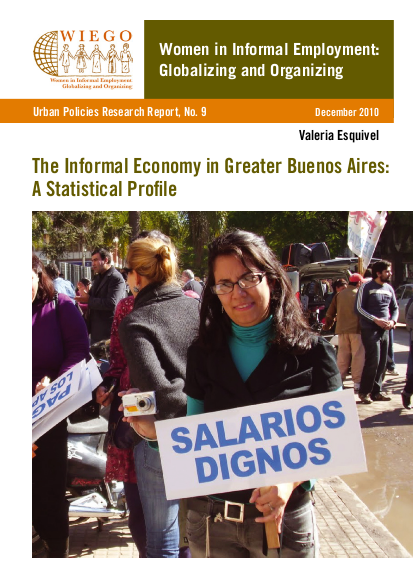
This report interrogates the nature of the informal economy in Greater Buenos Aires – the city of Buenos Aires and its surroundings. It takes advantage of the existence of a unique dataset, the Informal Labour Module (ILM), which was collected in 2005 as a module of Encuesta Permanente de Hogares (EPH). Among ILM’s objectives were characterizing informal employment, particularly through tackling the extent and reasons of wage employment; understanding the various ways in which the formality of the production unit relates to the formality of employment; and ultimately, to inform the debate and policy on informal employment in Argentina.
Informal employment is an extensive phenomenon in Greater Buenos Aires. Forty-five per cent of its 5.3 million workers are informal, as per the information collected by the ILM module in 2005. Informal employment is far more extensive than employment in the informal sector, which explained 20 per cent of total employment. In other words, less than half of all informal employment was found in the informal sector. Almost 7 out of 10 workers work for formal production units, as defined by the proxy variables used in the ILM. But working for a formal production unit does not guarantee being a formal worker: following the same example, roughly five out of these seven workers are formal, but two workers are not, even when the production unit they work for is formal. Lastly, as many as 8.2 per cent of workers in Greater Buenos Aires work for households, most of them in informal positions.
Women are more likely to be in informal employment than men: half of women workers are informal workers, while this proportion is 42 per cent among men. More than one third of informal female workers are domestic workers, employed by households; and roughly one sixth each works for formal (13.8%) or informal enterprises (14.1%). Men’s informal employment is more related to informal production units than women’s, as over half of all informal male workers work for informal enterprises. Informal employees and independent workers who work in informal production units, which constitute the informal sector, are in the most vulnerable position, and account for almost half of total informal employment. They are likely to be men, semi-skilled or unskilled, and concentrated in construction and trade (and transport, if they are informal employees). Their mean monthly earnings are only half the mean earnings of their counterparts (with the same status in employment), although informal independent workers are relatively better off than their waged counterparts.
Informal workers employed by formal enterprises account for a third of informal employment. Women are relatively more likely to belong to this group than men, with a high incidence of semi-skilled workers, and a concentration in manufacturing and trade. Although they are unprotected by the Labour Law, these workers’ mean monthly and hourly earnings are higher than informal employees in informal enterprises. The remaining group of informal workers is female domestic workers, employed by households. De jure and de facto discriminated against, these women have the lowest educational credentials and have the lowest monthly earnings among informal employees. They constitute a group of highly vulnerable female workers, for whom specific policies should be designed and implemented. Both this report and previous analyses based on the ILM point to the fact that the informal economy is highly heterogeneous in Greater Buenos Aires, and that policy measures should differ according to the existing groups of informal workers within the informal economy.
Resource collections
- Accountability to affected populations (AAP)
- UN Habitat - Urban Response Collection
- Urban Response - Urban Crisis Preparedness and Risk Reduction
- Urban Response Collection - Community Engagement and Social Cohesion
- Urban Response Collection - Economic Recovery
- Urban Response Collection - Environment and Climate Change
- Urban Response Collection - Housing, Land and Property
- Urban Response Collection - Urban Crisis Response, Recovery and Reconstruction
- Urban Response Collection - Urban Resilience